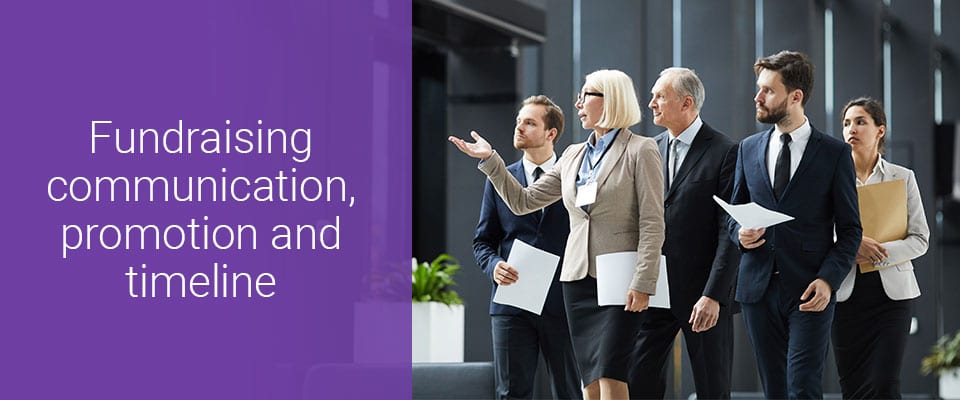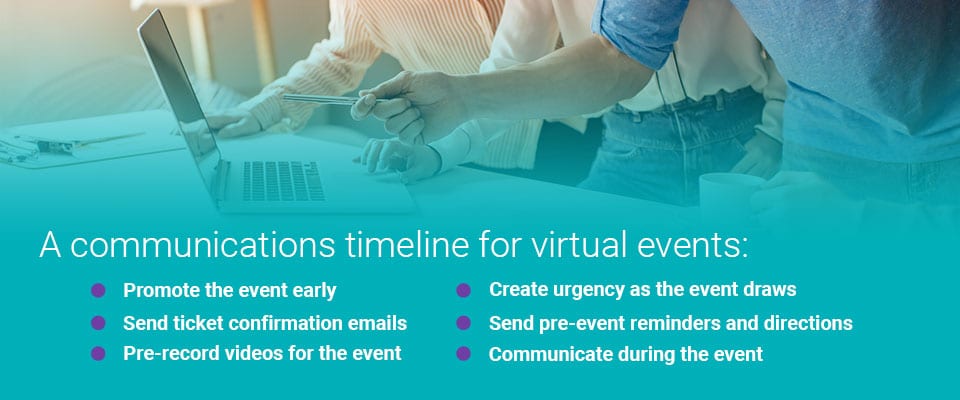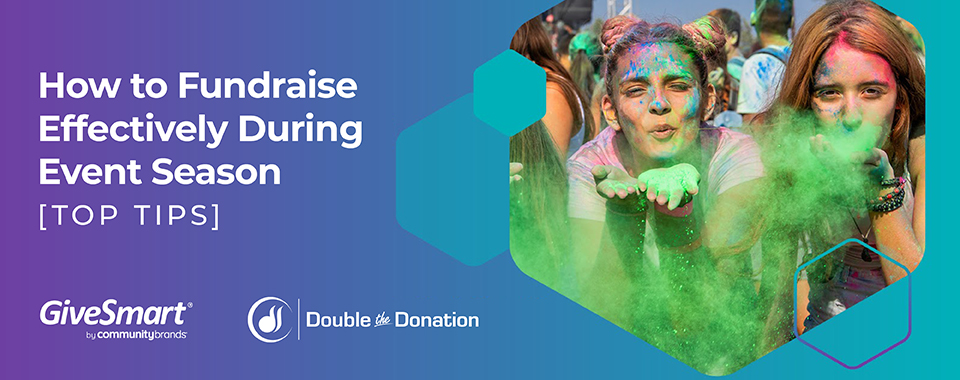Jul 26, 2021
Fundraising communication, promotion, and timeline

By generating awareness and connecting with your donors, you can ensure strong attendance at your next event and raise more money along the way. This nonprofit event communication guide is jampacked with tips to help you succeed.
Why fundraising communications are so crucial
Communicating with your attendees helps them prepare for and get excited about the event. It keeps awareness for your cause top of mind leading up to the big day. You’ll encourage more ticket buyers to attend the event and prime your attendees to give more during the fundraiser.
By previewing your auction items or raffle prizes, announcing your fundraising targets, and telling guests more about the excellent cause their gifts go toward, they’ll be more ready and excited to give on the day of.
A communications timeline for virtual events
Follow these email and social media timelines to create early buzz and more follow-through for your virtual event.
Promote the event early
Even when the event is months away and before you open ticket sales, you can build early excitement with these tactics.
- Newsletter mentions: Spotlight your upcoming virtual event in your newsletter months in advance.
- Social media posts: Nonprofit event social media promotions should appear on your page sparingly at first. Then, gradually increase posting as the day comes closer.
- Email appeals to previous attendees: If you have a guest list from earlier events, email them to let them know your next event is coming up. Tell them to mark their calendars or offer early-bird tickets.
Send ticket confirmation emails
When a donor first buys a ticket or signs up for your event, immediately enroll them in future communications. Simplify your nonprofit’s event email communications by adding every attendee to an email list. Send out a personalized confirmation email, which you can set up automatically in GiveSmart, including the following.
- Thanks: Saying “thank you for your support” helps attendees feel like their ticket makes a difference.
- What to expect: Depending on your timeline, the event might be next week or months away. Either way, give attendees a rundown of what’s to come. That may be a timeline of when they can expect other essential communications for the day of the fundraiser or the itinerary of the event itself.
- Option to share: The confirmation email can also offer guests the opportunity to share the event on social media or via email. Invite guests to encourage their friends to join in and make it easy to share in just a few taps or clicks.
Pre-record videos for the event
Many of the GiveSmart Community’s seasoned virtual event planners recommend using at least some pre-recorded videos during your virtual event. You can put these up live on your event website beforehand to introduce attendees and prospective attendees to your mission and initiatives.
Pre-recorded videos give you more control over your communications than a livestream and afford you the chance to show off more of what your organization does. Include clips of the people you’ve helped, your volunteer events, and other organizational highlights to show how donations will make an impact.
Create urgency as the event draws nearer
When the event is right around the corner, you can ramp up your promotions to gain more attendees and encourage a higher turnout. Consider these strategies.
- Social media countdowns: Leading up to the last day to buy tickets and to the event itself, engage your followers with countdowns on social media.
- Announce ticket sales: If you’re running out of tickets or the last day to buy a ticket is coming up, make a final push with an email to all your donors who haven’t yet purchased a ticket.
- Preview your prizes: Whether you’re holding a silent auction, live auction, or raffle, build excitement by highlighting some of the prizes and buy-now items. You can send these to your committed guests to help them plan their bids and to other donors to encourage them to buy a ticket or sign up for the event.
Send pre-event reminders and directions
Help your guests know what to expect in your final reminder email. Consider including:
- A virtual event website tour or tutorial.
- Directions on how to bid on items or buy raffle tickets.
- An event schedule.
- Another thank-you with an update on how much you’ve raised so far.
Communicate during the event
Your virtual event gives you an hour or so of uninterrupted time to communicate directly with your top supporters. Amid all the excitement and entertainment, engage your donors with tactics like these.
- Live appeals: During the livestream or in the pre-recorded video, ask guests directly for donations.
- Text messages: If your event includes a silent auction, live auction, or raffle, use text messages to keep donors informed. With GiveSmart, donors will get automatic text messages when someone outbids them or when they’ve won their item. As the auction is getting ready to close, you can also text guests to highlight items without any bids.
- Thank-yous: As the event draws to a close, thank all participants for their generosity and remind them what a worthy cause they’re helping. Talk about upcoming events and giving opportunities to build excitement and encourage donor retention.
The importance of communicating on safety
If you plan on holding an in-person or hybrid event, much of your communications timeline will stay the same, with one crucial caveat. With any live components, your communications must also highlight safety. Your early promotions must reassure guests, and your pre-event guest communications must explain your safety plans and expectations.
Effective safety communications will help guests feel better about buying tickets and attending the fundraiser. They’ll also ensure attendees know what to expect and follow all safety guidelines on the day of the event.
A nonprofit event messaging plan should include safety communications such as these.
- Guidance on choosing to attend: Remind guests to stay home and join virtually if they are experiencing any signs of illness or have tested positive for COVID-19.
- Refund policies: Make your refund policy evident. When people know they can get a refund if they choose not to attend or if the event gets postponed, they’ll feel more confident making the purchase.
- Safety plans: Make sure guests know whether you require a face covering if they are fully vaccinated and about all the safety precautions you’ll take at the event. Let them know if you’ll screen guests for symptoms and that you expect attendees to socially distance and follow all federal, state, and local guidelines.
- Scheduling: Changing developments in your area may cause you to reschedule the event or make it virtual. In this case, communicate with chief stakeholders to get feedback and make a final decision. Ensure registered attendees know about all changes as soon as possible.
Types of communications to leverage
When promoting your event and connecting with attendees, using many forms of communication helps you reach the most people based on their preferred method. Some modes of communication to consider include the following.
- Email: In 2020, nonprofits’ email lists grew by 3%. Use your contact list to your advantage by sending short emails with enticing subject lines to let previous donors and attendees know about your event.
- Text messages: Even more exciting, nonprofits’ mobile contact lists grew by 26% in 2020. Use text messages to engage attendees at the event itself, with notifications about your silent auction or programming. You can also set up a text-to-donate campaign.
- Social media: Turn your social media audience into an event audience. Engage them with regular posts and promotions.
- Mail: In the digital age, direct mail is still a powerful communication tool. It’s the second-most common way for donors to hear about a fundraiser, with 38% of donors saying mail was how they learned about a nonprofit event.
Master your nonprofit event communications with GiveSmart
GiveSmart is a full-featured fundraising platform with many tools to help you communicate and plan for a successful fundraiser. With user-friendly virtual event websites and ticketing management, we can help you with in-person and virtual events alike. With text notifications to support mobile bidding and text-to-donate campaigns, alongside campaign management, social media integrations, and more, we have all the tools you need to promote your event and communicate with guests.
See how GiveSmart can help you supercharge your next fundraiser by making giving feel effortless and streamlining communications. Schedule a live demo of GiveSmart’s fundraising tools today. Or watch our webinar on Communication, Promotion, and Timelines for more insights.
Related





